Passivity-Based Sliding Mode Control for the Robust Trajectory Tracking of Unmanned Surface Vessels Under External Disturbances and Model Uncertainty
Abstract
1. Introduction
2. Preliminaries
2.1. Port-Hamiltonian System
2.2. Momentum Transformation and Kinetic–Potential Energy Shaping
3. Problem Statement
4. Control Design
4.1. Radial Basis Function Neural Network-Based Uncertainty Estimator
4.2. Adaptive Disturbance Estimation
4.3. Energy-Based Sliding Mode Tracking Control of USV
- 1.
- Transformation of the Error SystemUsing the control law,the closed-loop error PHS is transformed intoThe time derivative of can be expressed asFor the time derivative of , we have
- 2.
- Further Transformation Using the Auxiliary Control Input vBy using the auxiliary control input,the system is converted into the closed-loop port-Hamiltonian form:The partial derivatives of regarding and are computed as follows:
- 3.
- Stability AnalysisFinally, we prove that the closed-loop error system (42) is asymptotically stable using the Lyapunov function .In order to establish the finite time convergence of the sliding variable , we introduce the following co-ordinate transformation:With the co-ordinate transformation applied, the closed-loop system is then expressed asWith the Hamiltonian, it is expressed asThe dynamic of the sliding variables, , is thenThe designed energy function, , can be considered a Lyapunov candidate function according to Assumption 2. Since is positive definite, we initially treat it as a Lyapunov candidate function. The specific condition will be addressed and computed in the subsequent proofs.In the closed-loop system (30), the reaching mode and sliding mode are analyzed separately to establish the upper bound of .Initially, during the reaching mode (), we studied the time derivative of .The above equation holds true under Assumptions 1 and 2.In the case of sliding modes, consider scenarios where some are equal to zero. Specifically, assume that there are k sub-sliding modes and sub-reaching modes. This implies that k components of are constrained to zero, while the remaining components have yet to reach zero, with . Define to represent the sliding mode components and to represent the reaching mode components. For simplicity, let and . Under these conditions, the dynamics of (48) can be expressed aswhere ∗ represents an arbitrary value. Based on (50) and Assumption 2, the following holds:In this context, denotes the maximum value of in the vicinity of the origin. The resulting system is characterized asBy calculating the time derivative of , we obtain the following:follows from Assumption 1, and is as shown below:In the reaching mode, , whereas in the sliding mode, .Thus, inequality (58) applies to the two cases, ensuring that the time derivative of is upper-bounded.By integrating (58) with respect to time, the designed energy function isreaches zero in finite time , which leads to the finite time convergence of to zero.Finally, we prove the asymptotic stability of the closed-loop system. The derivative of the Hamilton function in the reaching mode is computed asIf sub-sliding modes satisfy , then we have thatIn the state space of the equivalent system with , it also holds that in the sliding mode ,The dynamic of is thenIn conclusion, the above equation for the sliding surface ensures the asymptotic stability of the tracking errors.
5. Simulation
6. Conclusions
Author Contributions
Funding
Institutional Review Board Statement
Informed Consent Statement
Data Availability Statement
Conflicts of Interest
Abbreviations
| C | Combined Coriolis and centripetal forces |
| Damping matrix accounting for motion-related damping effects | |
| Linear damping coefficient in the surge direction | |
| Linear damping coefficient in the sway direction | |
| Linear damping coefficient in the yaw direction | |
| G | Input matrix to the Hamiltonian system after momentum transformation |
| Input matrix of the canonical fully-actuated mechanical Hamiltonian system | |
| H | Hamiltonian function after momentum transformation |
| Hamiltonian function of the canonical fully-actuated mechanical Hamiltonian system | |
| J | Transformation matrix related to the yaw Euler angle |
| M | Inertia matrix of the canonical fully-actuated mechanical Hamiltonian system |
| Inertia matrix accounting for added mass | |
| Added mass in the surge direction | |
| Added mass in the sway direction | |
| Added mass in the yaw direction | |
| p | Momentum |
| q | Configuration |
| T | Non-singular matrix for momentum transformation |
| u | Surge velocity |
| Surge velocity tracking errors | |
| Desired surge velocity | |
| v | Sway velocity |
| Sway velocity tracking errors | |
| Desired sway velocity | |
| r | Yaw velocity |
| Yaw velocity tracking errors | |
| Desired yaw velocity | |
| x | Surge displacement |
| y | Sway displacement |
| Tracking error term defined by the sliding variable | |
| Hamiltonian function of the closed-loop system | |
| U | Designed energy function |
| Sliding variable | |
| Control input | |
| Yaw angle | |
| Transformed momentum | |
| Desired transformed momentum | |
| Control vector consisting of forces and moments | |
| External disturbance vector | |
| Estimated external disturbance vector | |
| Model uncertainties in surge velocity | |
| Model uncertainties in sway velocity | |
| Model uncertainties in yaw velocity | |
| RBFNN output |
References
- Maschke, B.M.; van der Schaft, A.J. Port-controlled Hamiltonian systems: Modelling origins and systemtheoretic properties. IFAC Proc. Vol. 1993, 25, 359–365. [Google Scholar] [CrossRef]
- Van Der Schaft, A.; Jeltsema, D. Port-Hamiltonian systems theory: An introductory overview. Found. Trends® Syst. Control. 2014, 1, 173–378. [Google Scholar] [CrossRef]
- Duindam, V.; Macchelli, A.; Stramigioli, S.; Bruyninckx, H. Modeling and Control of Complex Physical Systems: The Port-Hamiltonian Approach; Springer Science and Business Media: Berlin/Heidelberg, Germany, 2009. [Google Scholar]
- Ramirez, H.; Le Gorrec, Y. Interconnection of irreversible port Hamiltonian systems. Automatica 2024, 170, 111846. [Google Scholar] [CrossRef]
- Zhou, W.; Hamroun, B.; Le Gorrec, Y.; Couenne, F. Infinite dimensional port Hamiltonian representation of reaction diffusion processes. IFAC-PapersOnLine 2015, 48, 476–481. [Google Scholar] [CrossRef]
- Zhou, W.; Hamroun, B.; Le Gorrec, Y.; Couenne, F. Infinite dimensional port Hamiltonian representation of chemical reactors. IFAC Proc. Vol. 2012, 45, 248–253. [Google Scholar] [CrossRef]
- Liu, N.; Wu, Y.; Le Gorrec, Y. Energy-based modeling of ionic polymer–metal composite actuators dedicated to the control of flexible structures. IEEE/ASME Trans. Mechatron. 2021, 26, 3139–3150. [Google Scholar] [CrossRef]
- Wu, Y.; Hamroun, B.; Le Gorrec, Y.; Maschke, B. Structure preserving reduction of port hamiltonian system using a modified lqg method. In Proceedings of the 33rd Chinese Control Conference, Nanjing, China, 28–30 July 2014; pp. 3528–3533. [Google Scholar]
- Maschke, B.; Ortega, R.; Van Der Schaft, A.J. Energy-based Lyapunov functions for forced Hamiltonian systems with dissipation. IEEE Trans. Autom. Control. 2002, 45, 1498–1502. [Google Scholar] [CrossRef]
- Van der Schaft, A. L2-Gain and Passivity Techniques in Nonlinear Control; Springer: Berlin/Heidelberg, Germany, 2000. [Google Scholar]
- Ortega, R.; Nicklasson, P.J. Passivity-Based Control of Euler-Lagrange Systems: Mechanical, Electrical and Electromechanical Applications; Springer: Berlin/Heidelberg, Germany, 1998. [Google Scholar]
- Ortega, R.; Van Der Schaft, A.J.; Mareels, I.; Maschke, B. Putting energy back in control. IEEE Control. Syst. Mag. 2001, 21, 18–33. [Google Scholar]
- Ortega, R.; Van Der Schaft, A.; Maschke, B.; Escobar, G. Interconnection and damping assignment passivity-based control of port-controlled Hamiltonian systems. Automatica 2002, 38, 585–596. [Google Scholar] [CrossRef]
- Romero, J.G.; Donaire, A.; Ortega, R. Robust energy shaping control of mechanical systems. Syst. Control. Lett. 2013, 62, 770–780. [Google Scholar] [CrossRef]
- Ortega, R.; Van Der Schaft, A.; Castanos, F.; Astolfi, A. Control by interconnection and standard passivity-based control of port-Hamiltonian systems. IEEE Trans. Autom. Control. 2008, 53, 2527–2542. [Google Scholar] [CrossRef]
- Ortega, R.; Garcia-Canseco, E. Interconnection and damping assignment passivity-based control: A survey. Eur. J. Control. 2004, 10, 432–450. [Google Scholar] [CrossRef]
- Donaire, A.; Romero, J.G.; Perez, T. Trajectory tracking passivity-based control for marine vehicles subject to disturbances. J. Frankl. Inst. 2017, 354, 2167–2182. [Google Scholar] [CrossRef]
- Lv, C.; Yu, H.; Chi, J.; Xu, T.; Zang, H.; Jiang, H.I.; Zhang, Z. A hybrid coordination controller for speed and heading control of underactuated unmanned surface vehicles system. Ocean Eng. 2019, 176, 222–230. [Google Scholar] [CrossRef]
- Reyes-Báez, R.; van der Schaft, A.; Jayawardhana, B. Virtual contractivity-based control of fully-actuated mechanical systems in the port-Hamiltonian framework. Automatica 2022, 141, 110275. [Google Scholar] [CrossRef]
- Slotine, J.J.E.; Li, W. Applied Nonlinear Control; Prentice Hall: Englewood Cliffs, NJ, USA, 1991. [Google Scholar]
- Young, K.D.; Utkin, V.I.; Ozguner, U. A control engineer’s guide to sliding mode control. IEEE Trans. Control. Syst. Technol. 1999, 7, 328–342. [Google Scholar] [CrossRef]
- Edwards, C.; Spurgeon, S. Sliding Mode Control: Theory and Applications; CRC Press: Boca Raton, FL, USA, 1998. [Google Scholar]
- Fridman, L.; Levant, A. Higher order sliding modes. Sliding Mode Control. Eng. 2002, 11, 53–102. [Google Scholar]
- Levant, A. Higher-order sliding modes, differentiation and output-feedback control. Int. J. Control. 2003, 76, 924–941. [Google Scholar] [CrossRef]
- Slotine, J.J.; Coetsee, J.A. Adaptive sliding controller synthesis for non-linear systems. Int. J. Control. 1986, 43, 1631–1651. [Google Scholar] [CrossRef]
- Ashrafiuon, H.; Muske, K.R.; McNinch, L.C.; Soltan, R.A. Sliding-mode tracking control of surface vessels. IEEE Trans. Ind. Electron. 2008, 55, 4004–4012. [Google Scholar] [CrossRef]
- Gonzalez-Garcia, A.; Castañeda, H. Guidance and control based on adaptive sliding mode strategy for a USV subject to uncertainties. IEEE J. Ocean. Eng. 2021, 46, 1144–1154. [Google Scholar] [CrossRef]
- Jiang, T.; Yan, Y.; Yu, S.H. Adaptive sliding mode control for unmanned surface vehicles with predefined-time tracking performances. J. Mar. Sci. Eng. 2023, 11, 1244. [Google Scholar] [CrossRef]
- Sakata, N.; Fujimoto, K.; Maruta, I. Passivity-based sliding mode control for mechanical port-Hamiltonian systems. IEEE Trans. Autom. Control. 2024, 69, 5605–5612. [Google Scholar] [CrossRef]
- Fujimoto, K.; Sakata, N.; Maruta, I.; Ferguson, J. A passivity based sliding mode controller for simple port-Hamiltonian systems. IEEE Control. Syst. Lett. 2020, 5, 839–844. [Google Scholar] [CrossRef]
- Fujimoto, K.; Baba, T.; Sakata, N.; Maruta, I. A passivity-based sliding mode controller for a class of electro-mechanical systems. IEEE Control. Syst. Lett. 2021, 6, 1208–1213. [Google Scholar] [CrossRef]
- Er, M.J.; Wu, S.; Lu, J.; Toh, H.L. Face recognition with radial basis function (RBF) neural networks. IEEE Trans. Neural Netw. 2002, 13, 697–710. [Google Scholar]
- Vt, S.E.; Shin, Y.C. Radial basis function neural network for approximation and estimation of nonlinear stochastic dynamic systems. IEEE Trans. Neural Netw. 1994, 5, 594–603. [Google Scholar]
- Zhou, W.; Xu, Z.; Wu, Y.; Xiang, J.; Li, Y. Energy-based trajectory tracking control of under-actuated unmanned surface vessels. Ocean Eng. 2023, 288, 116166. [Google Scholar] [CrossRef]
- Ferguson, J.; Donaire, A.; Middleton, R.H. Kinetic-potential energy shaping for mechanical systems with applications to tracking. IEEE Control. Syst. Lett. 2019, 3, 960–965. [Google Scholar] [CrossRef]
- Fossen, T.I. Guidance and Control of Ocean Vehicles. Ph.D. Thesis, University of Trondheim, Trondheim, Norway, 1999. [Google Scholar]
- Fossen, T.I. Marine Control Systems–Guidance. Navigation, and Control of Ships, Rigs and Underwater Vehicles; Marine Cybernetics: Trondheim, Norway, 2002; ISBN 82 92356 00 2. Available online: www.marinecybernetics.com (accessed on 19 January 2025).
- Astolfi, A.; Ortega, R. Immersion and invariance: A new tool for stabilization and adaptive control of nonlinear systems. IEEE Trans. Autom. Control. 2003, 48, 590–606. [Google Scholar] [CrossRef]
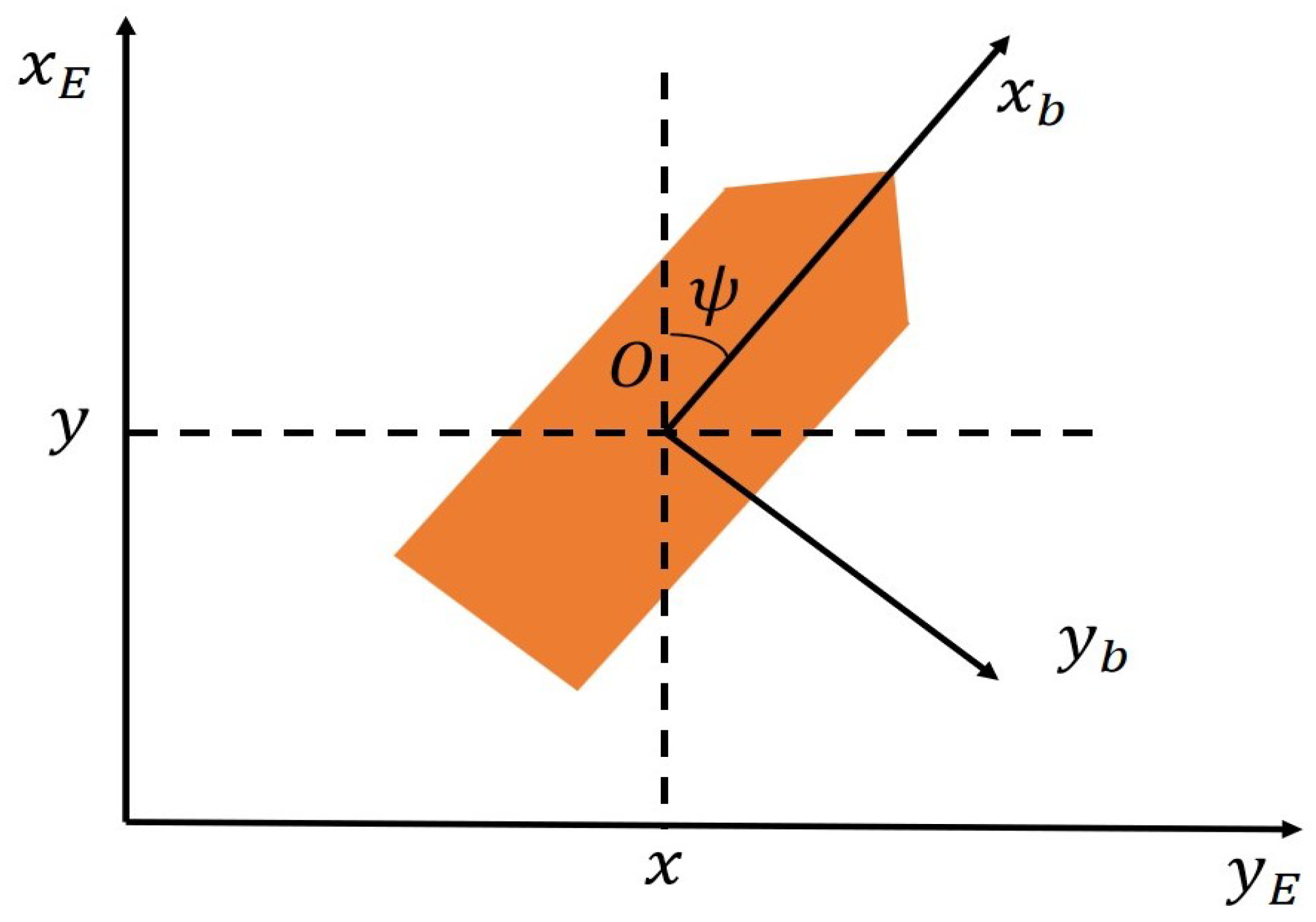
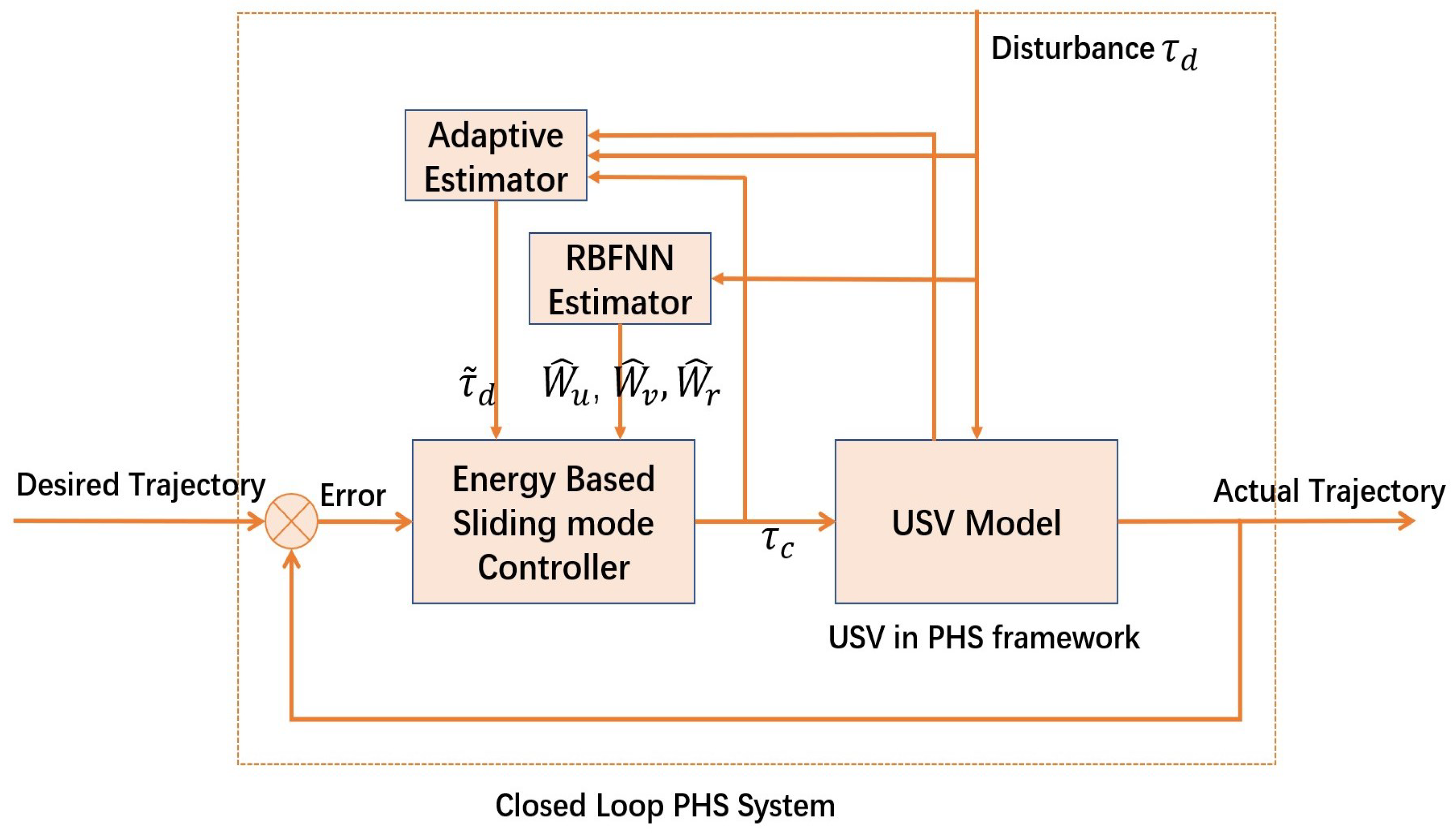
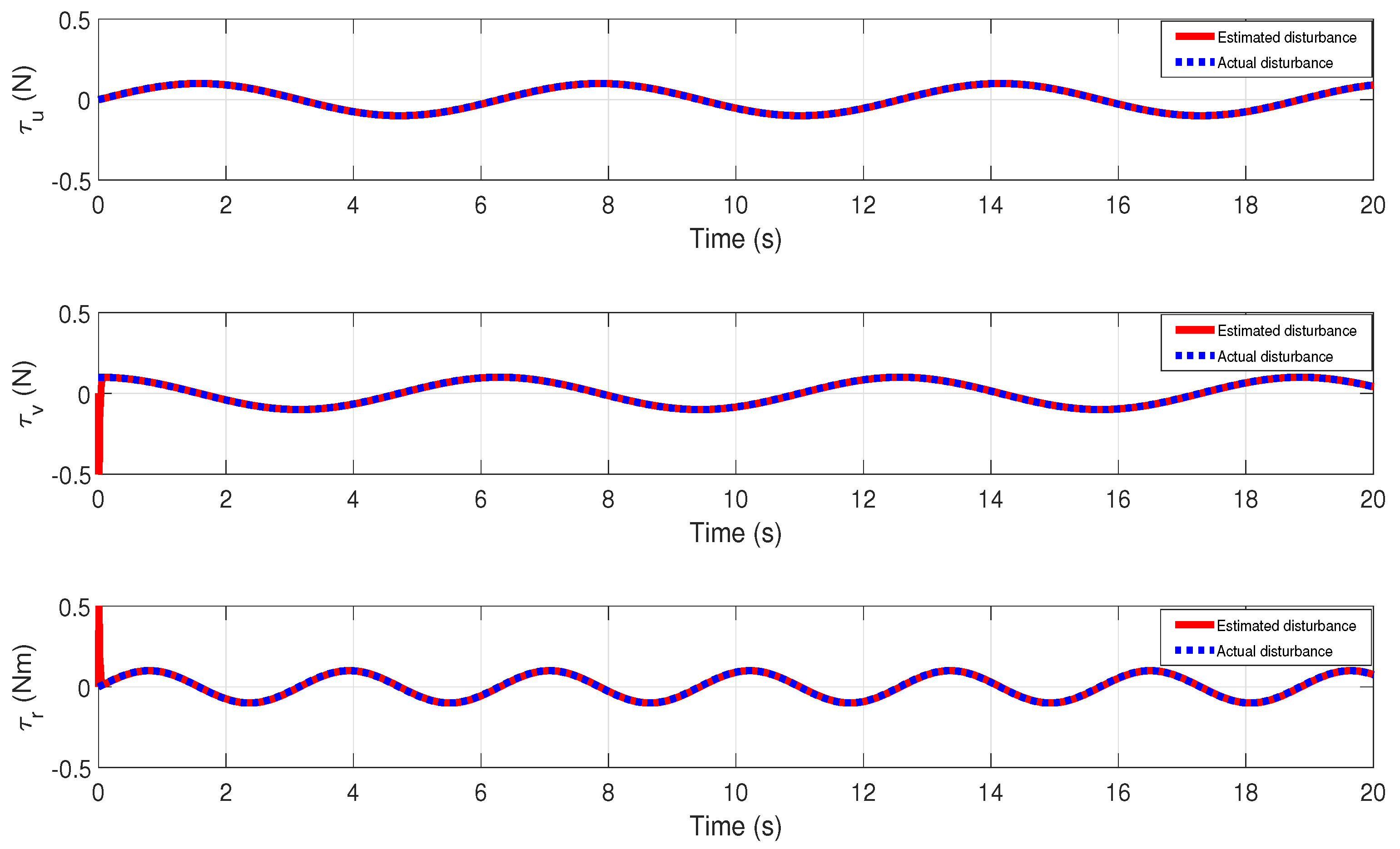



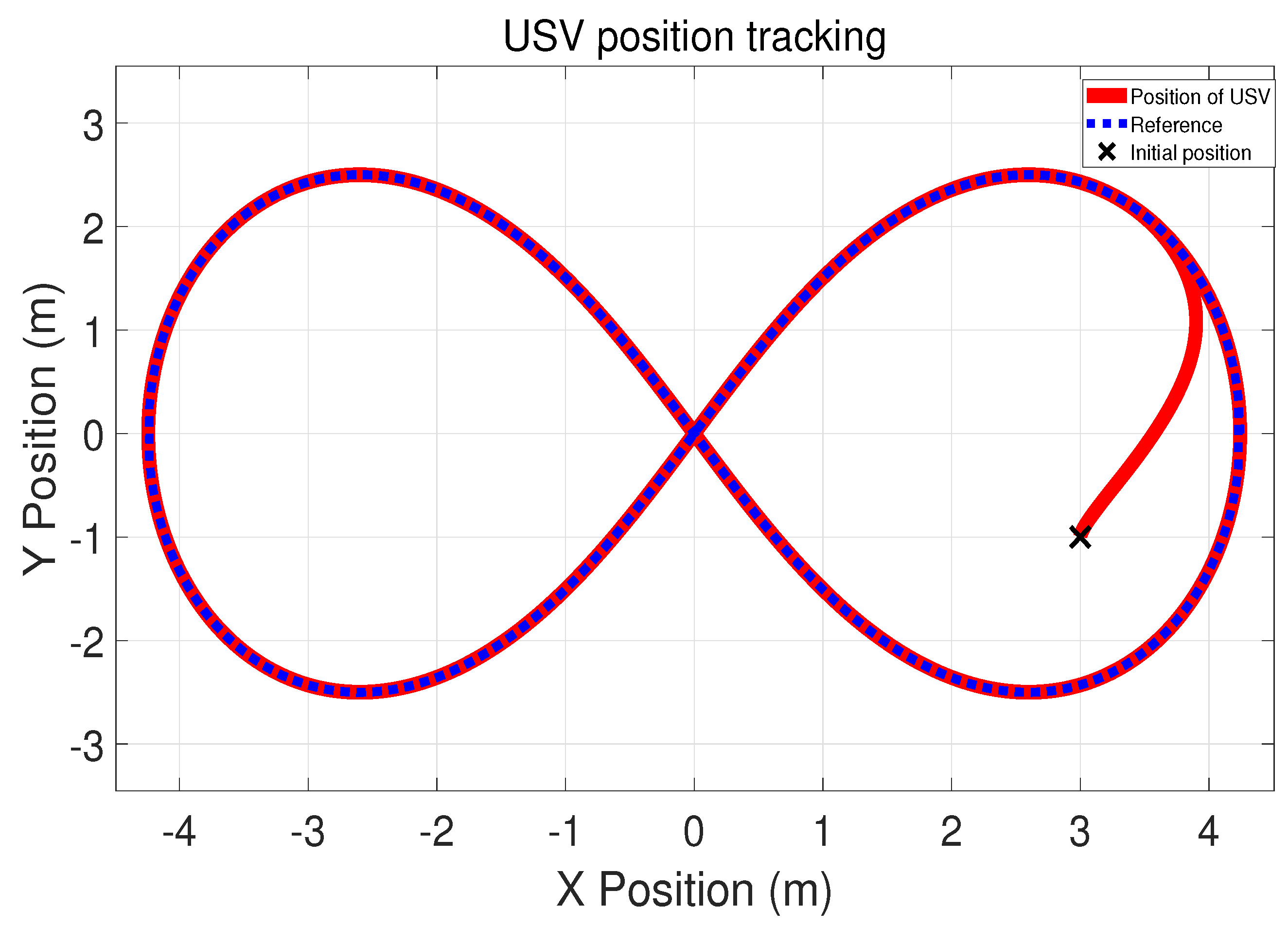

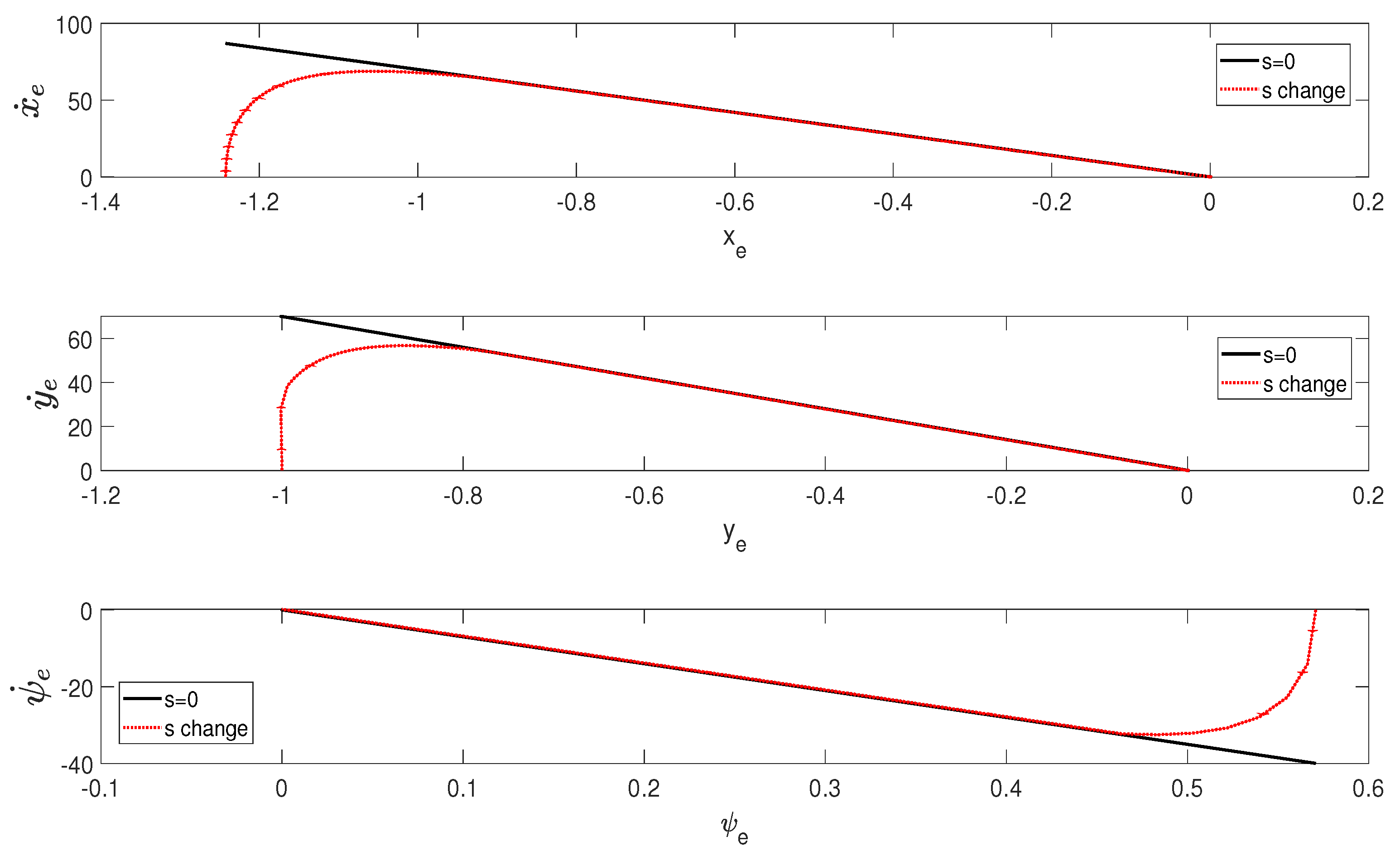
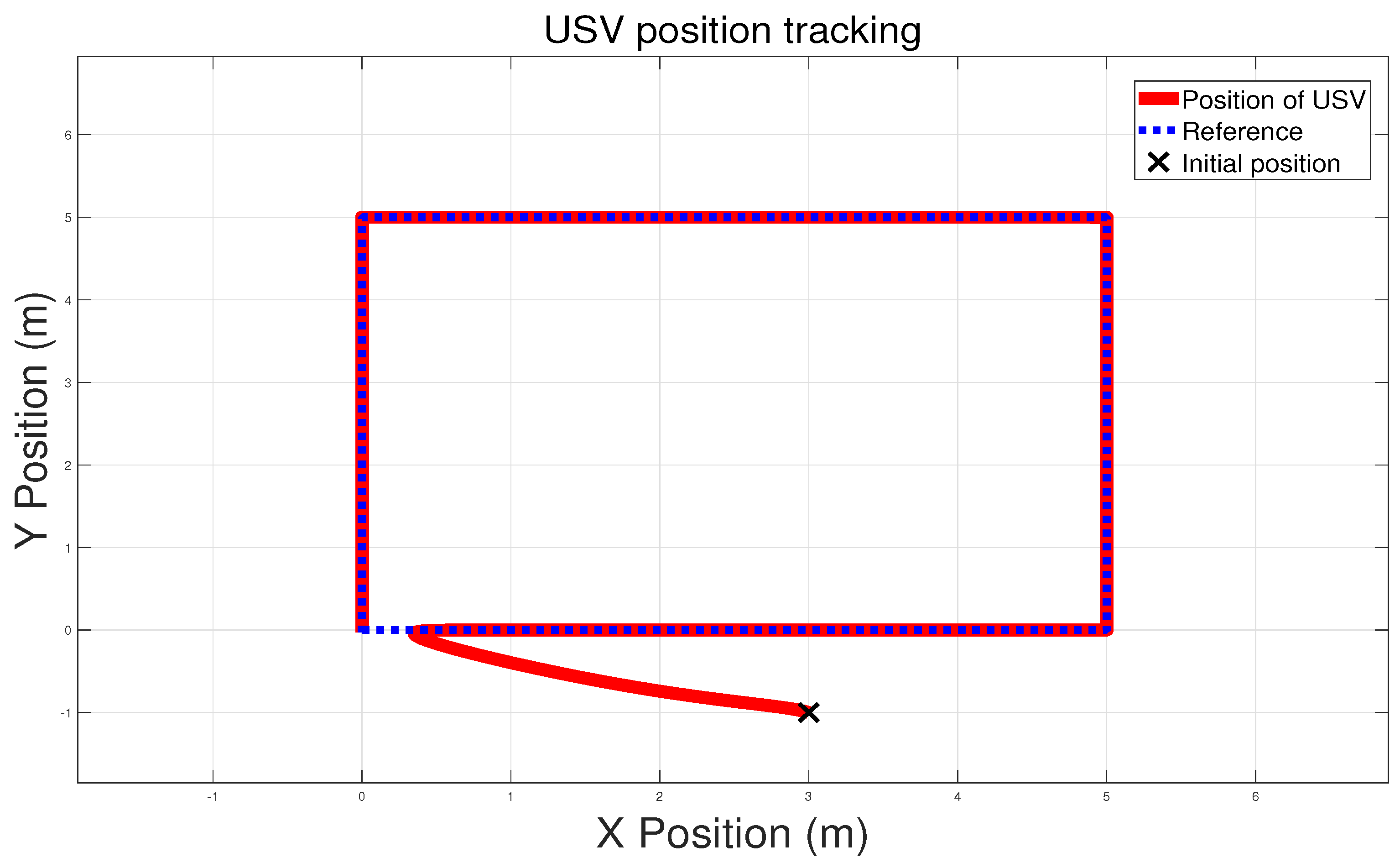
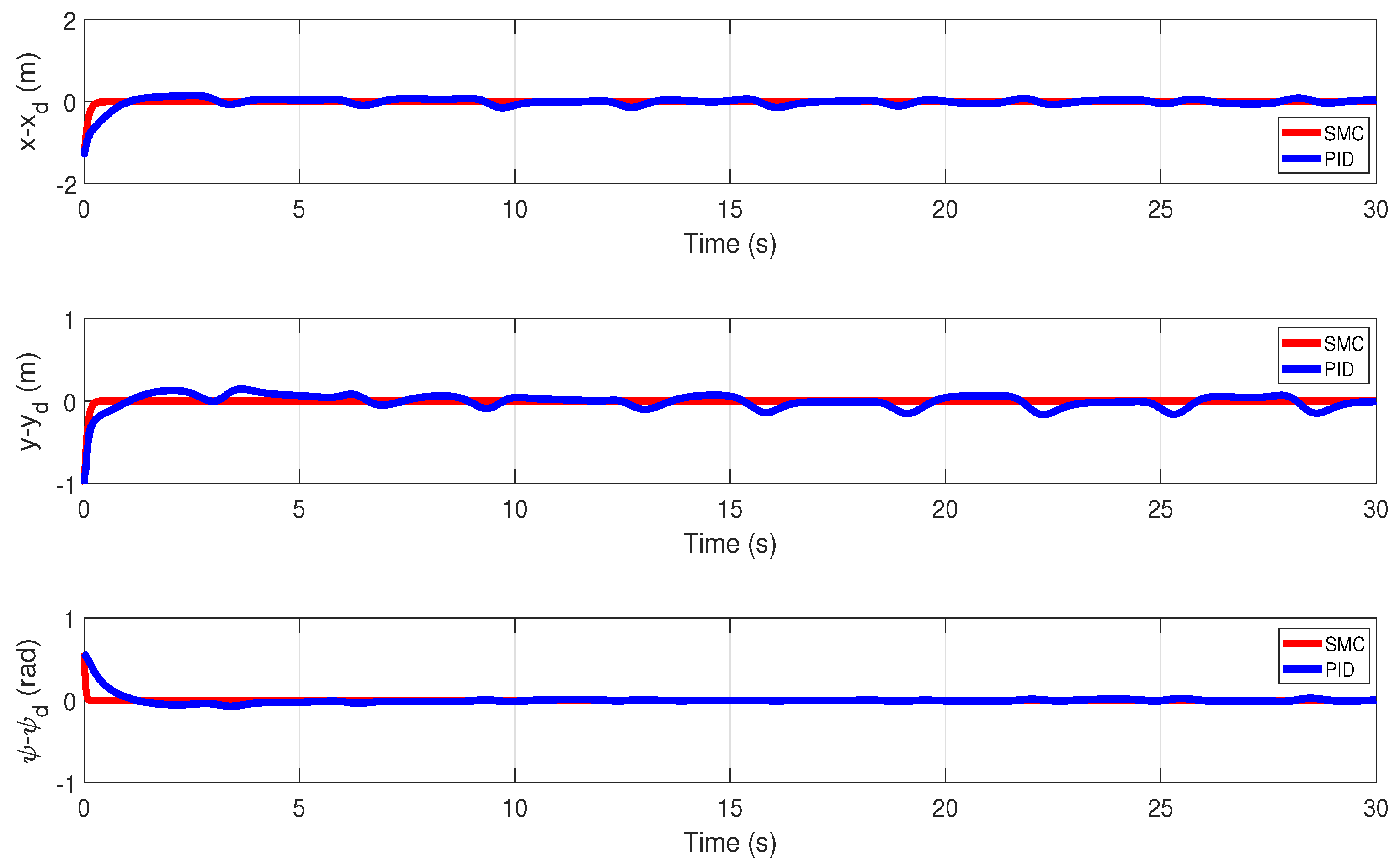

Disclaimer/Publisher’s Note: The statements, opinions and data contained in all publications are solely those of the individual author(s) and contributor(s) and not of MDPI and/or the editor(s). MDPI and/or the editor(s) disclaim responsibility for any injury to people or property resulting from any ideas, methods, instructions or products referred to in the content. |
© 2025 by the authors. Licensee MDPI, Basel, Switzerland. This article is an open access article distributed under the terms and conditions of the Creative Commons Attribution (CC BY) license (https://creativecommons.org/licenses/by/4.0/).
Share and Cite
Ma, L.; Pang, S.; He, Y.; Wu, Y.; Li, Y.; Zhou, W. Passivity-Based Sliding Mode Control for the Robust Trajectory Tracking of Unmanned Surface Vessels Under External Disturbances and Model Uncertainty. J. Mar. Sci. Eng. 2025, 13, 364. https://doi.org/10.3390/jmse13020364
Ma L, Pang S, He Y, Wu Y, Li Y, Zhou W. Passivity-Based Sliding Mode Control for the Robust Trajectory Tracking of Unmanned Surface Vessels Under External Disturbances and Model Uncertainty. Journal of Marine Science and Engineering. 2025; 13(2):364. https://doi.org/10.3390/jmse13020364
Chicago/Turabian StyleMa, Luke, Siyi Pang, Yao He, Yongxin Wu, Yanjun Li, and Weijun Zhou. 2025. "Passivity-Based Sliding Mode Control for the Robust Trajectory Tracking of Unmanned Surface Vessels Under External Disturbances and Model Uncertainty" Journal of Marine Science and Engineering 13, no. 2: 364. https://doi.org/10.3390/jmse13020364
APA StyleMa, L., Pang, S., He, Y., Wu, Y., Li, Y., & Zhou, W. (2025). Passivity-Based Sliding Mode Control for the Robust Trajectory Tracking of Unmanned Surface Vessels Under External Disturbances and Model Uncertainty. Journal of Marine Science and Engineering, 13(2), 364. https://doi.org/10.3390/jmse13020364






